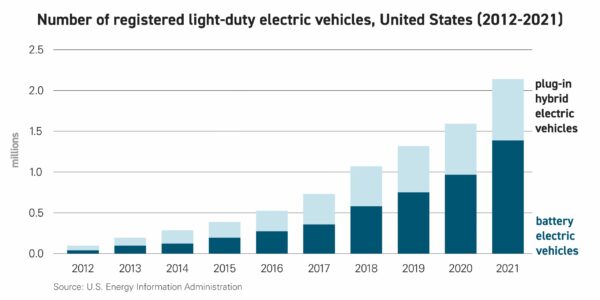Electric Vehicles (EVs) have recently grown in popularity and what was once a nuance to own, is now becoming mainstream. The Tesla Model Y was one of the top 5, best-selling models (both cars and SUV’s) in the U.S. for the first half of 2023, while the Tesla Model 3 was the second best-selling car, behind only the Toyota Camry.

EVs make up less than 5% of the vehicles in operation within the U.S., but their quick rise in popularity presents opportunities and challenges as businesses seek ways to adjust. EVs disrupt the traditional mobility model with one of the major shifts being the recharging processes.
The Advantages
Combustion-powered vehicles require refueling at dedicated stations, but EVs can theoretically recharge anywhere that has electricity without the complexity of owning a gas station. While recharging, the driver and occupants are restricted to the local area, which creates opportunities for your business.
- Increased foot traffic.
- Competitive advantage by providing convenience.
- Supply EV charging for employees.
When evaluating whether an EV charging station is a good solution for you, it is important to weigh the cost and benefits, holistically. As with all asset purchases, it is best to look at the total cost of ownership. For EV charging systems, this includes upfront costs, electric usage, inspections, and maintenance.
The Factors to Consider
When adding up the total investment of ownership for an EV charging system, the price to install the equipment varies by location, but can be obtained through an installation partner. The routine maintenance costs and inspections are more predictable and can be performed by the same installation partner. This leaves electricity as one of the more challenging components to calculate.
Electricity can impact EV charging systems in two ways: the infrastructure upgrades and the ongoing cost of power. Price variables are driven by how fast it takes to charge the vehicles. Fast charging (Level 3) is primarily for customer usage. When designing for employee use, slower chargers (Level 2) can be used since the employee will be at the location for a longer period, and the solution can be layered with intelligent software to help minimize impacts at the site.
Infrastructure Upgrades
When considering the installation of a fast-charging system, one thing to consider is how much excess electrical capacity there is for the location. There are three common ways to determine the total capacity available:
- Your utility representative can let you know.
- Electrical drawings for the building, such as: construction drawings, single line diagram, or an arc flash report.
- The transformer nameplate at the service entrance will list capacity.
Once capacity is known, you need to determine how much you are currently using. For an estimate, you can look at one of your higher electric bills, where one of the meter readings or billing lines should show the highest kW demand for that month. This value is a decent proxy for reference but will be lower than the actual instantaneous draw.
The difference between the total capacity available and the current demand is the excess capacity. If the charger size you are considering is less than the excess capacity, then the infrastructure upgrade costs should be minimal. If it is greater than the excess capacity, then you will need to reach out to the utility company or install additional equipment like a battery or perhaps capacitor banks. If required, the utility company can let you know what costs are on their end to upgrade your service or change your rate class.
The Cost of Power
The second electric impact at the site is the ongoing cost of power. EV chargers can dramatically change the way the site uses electricity. It will now draw very high loads for a short duration and repeat this throughout the day.
For many commercial locations, around 30% – 60% of the bill is based on fixed charges, and the most common way to recoup this is through demand charges ($/kW). With the charger making those high draws, it can dramatically increase the fixed cost allocation on the bill. Also, it may require the site to go to a different rate class. Like the infrastructure, in areas where there is a pronounced impact on the utility bill, adding a battery to the project may help mitigate electric cost increases.
As an example, adding a 150kW charger increased the bill by 40%. Alternatively, adding a 60kW charger in a similar circumstance increased the bill 20%. It is important to have a full understanding of the tradeoffs prior to installing charging equipment, so the best decision can be made.
In Closing
Electric vehicles are growing in popularity for both our personal and professional lives. When it comes to choosing EVs for your business, it is important to be prepared and understand the factors that go into them. Cost, infrastructure, business growth, and meeting sustainability goals are all things to consider when looking into electric vehicles.
Interested in learning more?
If you’ve found this blog informative and would like to learn more, please contact us online.
